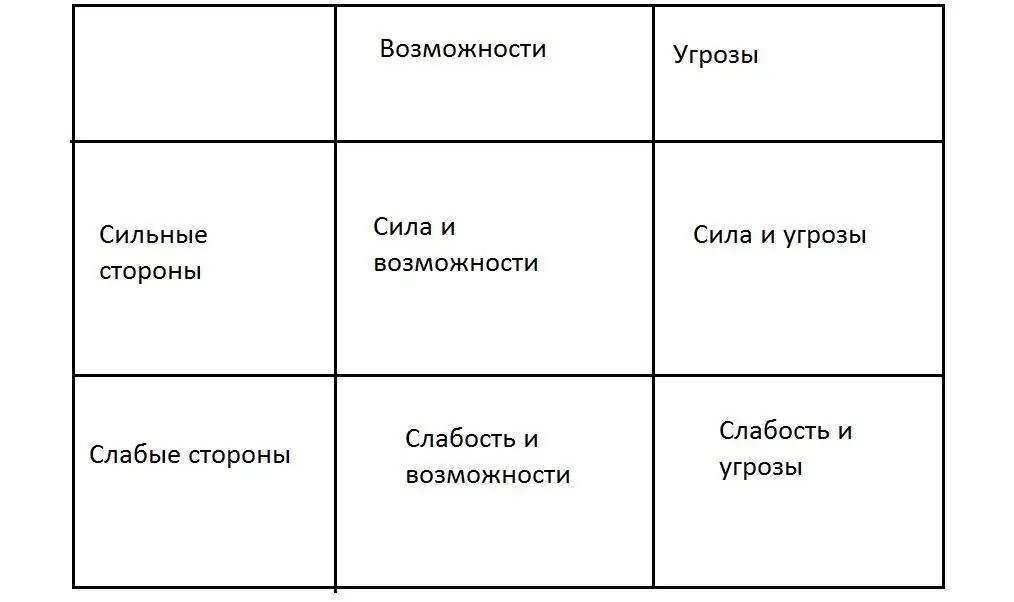2026 Author: Howard Calhoun | [email protected]. Last modified: 2025-06-01 07:12:56
The concept of SWOT-analysis is more or less defined in the field of marketing and management. But the definition of "SNW-analysis" often causes some confusion. Let's try to understand these meanings together and find out the main features of these components.
SNW analysis: what is it
Analysis of the internal environment of a firm or enterprise is a cumulative assessment of an enterprise or organization that fully reflects its strengths, weaknesses and neutrals. In the field of marketing, the definition of "SNW analysis" is somewhat similar to the definition of SWOT analysis, but in the first there is still a zero aspect of the study. SNW is a common abbreviation of three words of English origin (S is strong, N is neutral and W is weak).

As practice shows, SNW-analysis of the internal environment of an enterprise is a fairly effective way to determine the competitiveness of an organization, in which it is best to choose the average market state for a certain situation as a neutral position. Thus, it is fixedcalled the zero point of competition. What does this give the company? First of all, it allows you to identify the strongest side of the organization and improve it, that is, to position the company in a particular market.
5 aspects of SNW analysis
General analysis of the internal environment consists of the following aspects:
- Marketing.
- Finance.
- Operations.
- Human resources.
- Culture and corporation.
1. Marketing, in turn, consists of the following components: market share, enterprise competitiveness, range and quality of products (services), market conditions, sales, advertising and product positioning.
2. An analysis of the financial situation in an organization allows you to evaluate the effectiveness of strategic planning, as well as identify potential weaknesses in the organization and its position relative to competitors.
3. In any organization, an essential role is given to the analysis of management operations.
4. As they say, cadres are everything. That is why human resources, namely the qualifications of employees, their attitude to the goals set, as well as the competence of employees and management in general, play one of the most important roles in the efficiency of an enterprise.
5. Corporate culture is an unconventional factor that nevertheless plays a significant role in the entire organization. Agree, without a favorable climate in the team, it is difficult to establish relations between employees and achieve effective fulfillment of tasks. Fromthe well-coordinated work of all structural divisions largely depends on the success of the organization.

SNW approach
As already mentioned, the SNW approach is a more advanced analysis of the strengths and weaknesses of the organization. This approach has the following goals: to identify the strongest sides and engage in their improvement, and weaknesses in order to eliminate them altogether or make them stronger. In addition, it is recommended to define the so-called medium-term state, which will allow to determine a more complete picture of the organization's activities. So, it often happens that a particular firm in the competition is in almost all, with the exception of one, key positions in state N, and only in one position - in state S. The neutral position is the average state of the organization for a certain period of time.
Methodology
SNW-analysis of the enterprise examines the following aspects of the internal environment of the organization:

- The organization's core business strategy.
- The competitiveness of a product, product or service in the relevant market.
- Availability of certain funds.
- Brand performance, innovation and employee performance.
- Marketing and production level.
In order to thoroughly analyze the internal environment of the organization, the SNW analysis method is used, which for the most part comes down to filling out the following table:
| Strategic position | Strong - S | Neutral - N | Weak - W |
| Organization strategy | |||
| Org. structure | |||
| Financial status | |||
| Current balance | |||
| Accounting level | |||
| Finance as infrastructure | |||
| Availability of investment resources | |||
| Finance as a level of financial management | |||
| Product as overall competitiveness | |||
| Cost structure (overall) | |||
| Distribution as a distribution system | |||
| Distribution as a material structure | |||
| Distribution as Mastery of the Selling Process | |||
|
Information Technology |
|||
| Innovation as a waysales of products in the respective market | |||
| Ability to lead | |||
| Ability to lead a leader | |||
| Each employee's ability to lead | |||
| Ability to lead as aggregate objective factors | |||
| Overall production level | |||
| Efficiency of the material base | |||
| Workforce performance | |||
| Marketing level | |||
| Degree of management | |||
| Brand quality | |||
| Market reputation | |||
| Reputation as an employer | |||
| Relations with authorities | |||
| Relations with trade unions | |||
| Innovation as R&D | |||
| After Direct Sales Service | |||
| Degree of vertical integration | |||
| Corporate culture of the enterprise | |||
| Strategic alliances |
Result of SNW analysis

As a result, a very clear picture should emerge before specialists: with the SNW approach, all the advantages of the analysis remain in force, and the SNW analysis captures a clear situation on the market. Thus, with the help of special programs, it is possible to compare the obtained indicators with the strategy of the organization and determine the further direction of activity, that is, to optimize the management process itself, making it even more efficient.
Recommended:
Fundamental market analysis. Technical and fundamental analysis

Fundamental analysis is a set of methods that allow predicting events in the market or in its segments under the influence of external factors and events
Analysis of the situation: options, features, stages and results of the analysis

What is situation analysis? Who and when conducts it, the main stages of the analysis and assessment of the situation. Methods and tools used in the analysis of the situation. Why should it be carried out? What is the importance of the analysis of the situation for the work of the enterprise?
Analysis of shares: methods of conducting, choosing methods of analysis, tips and tricks

What are stocks. How to analyze stocks, what sources of information are used for this. What are the risks associated with buying shares? Types of stock analysis, what formulas are used. What are the features of the analysis of shares of Russian companies, tips and tricks for collecting information and analyzing shares
Multivariate analysis: types, examples, methods of analysis, purpose and results

Variance multivariate analysis is a combination of various statistical methods that are designed to test hypotheses and the relationship between the factors under study and certain features that do not have a quantitative description. Also, this technique allows you to determine the degree of interaction of factors and their influence on certain processes. All these definitions sound quite confusing, so let's understand them in more detail in our article
Analysis of the break-even of the enterprise. Break-even analysis of production

A break-even analysis is a process by which a business can decide how much to produce and sell finished products. This allows you to determine when you can cover an expense item

